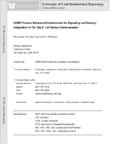|
|
Creator | Title | Description | Subject | Date |
| 251 |
 |
Bastiani, Michael | Guidance of neuronal growth cones in the grasshopper embryo. IV. Temporal delay experiments | In the previous 3 papers, we demonstrated that neuronal growth cones display selective affinities for both specific axonal and glial pathways in the grasshopper embryo; for example, the pCC growth cone selectively recognizes the MPl/dMP2 axons, while the aCC growth cone selectively recognizes the U... | Pathways; Neurons; Axons | 1986 |
| 252 |
 |
Bastiani, Michael | Guidance of neuronal growth cones: selective fasciculation in the grasshopper embryo | One of the central questions of developmental neurobiology concerns how the diversity and specificity of individual neurons are generated during embryonic development. One major component of neuronal diversity is the complex axonal morphology of individual neurons, largely generated early in develop... | Neurons; Filopodia; Axon | 1983 |
| 253 |
 |
Coley, Phyllis D. | Guía de los arboles comunes del Parque Nacional Soberanía, Panamá | Esta es una guía con dibujos para las cincuenta especies de árboles más comunes del bosque tropical en los alrededores del Parque Soberanía, Panamá. También se incluyen siete especies de hierbas y cuatro herbáceas grandes que sobresalen en el sotobosque (bosque bajo). Aunque en el área del p... | Arboles; Arbustos | 1984 |
| 254 |
 |
Sekercioglu, Cagan | Habitat use and movements of native forest birds in southern Costa Rican agricultural countryside | We used radio telemetry to study the habitat use, activity budgets, and movements of three bird species that are found in native forest and coffee plantations of southern Costa Rica. We obtained 7522 locations from Turdus assimilis (n=27), Tangara icterocephala (n=53), and Catharus aurantiirostris (... | | 2003-01-01 |
| 255 |
 |
Parkinson, John Stansfield | HAMP domain structural determinants for signalling and sensory adaptation in Tsr, the E. coli serine chemoreceptor | Motile Escherichia coli cells track chemical gradients with high sensitivity over wide concentration ranges [recently reviewed in (Hazelbauer et al., 2008; Hazelbauer & Lai, 2010)]. Stimulus detection, amplification, and integration occur in an arrayed network of signaling complexes that contain tra... | | 2014-01-01 |
| 256 |
 |
Capecchi, Mario R. | Hematopoietic origin of pathological grooming in Hoxb8 mutant mice | Mouse Hoxb8 mutants show unexpected behavior manifested by compulsive grooming and hair removal similar to humans with OCD-spectrum disorder trichotillomania. Since Hox gene disruption often has pleiotropic effects, the root cause of this behavioral deficit was unclear. Here we report that, in the b... | | 2010 |
| 257 |
 |
Coley, Phyllis D. | Herbivory and defensive characteristics of tree species in a lowland tropical forest | Rate of herbivory and defensive characteristics of young and mature leaves were measured for saplings of 46 canopy tree species in a lowland tropical rain forest (Barro Colorado Island, Panama). Grazing rates were determined in the field for sample periods in the early wet, late wet, and dry seasons... | Fiber; Herbivory; Life history; Panama; Phenolics; Plant growth; Spatial distribution; Tannins; Temporal distribution; Treefall gaps; Tropical forest | 1983 |
| 258 |
 |
Davidson, Diane W. | Herbivory on planted dipterocarp seedlings in secondary logged forests and primary forests of Sabah, Malaysia | Leaf defences, leaf nutritional quality and leaf expansion rates may vary with resource availabilities to plants. Such variation could affect rates of leaf loss to herbivores, particularly along the steep resource gradients in disturbed forests. Intraspecific and interspecific variation in leaf dama... | Danum Valley; Dipterocarp; Dryobalanops lanceolata; Herbivory rates; Leaf damage; Leaf expansion rates; Logged tropical forests; Secondary forests; Shorea leprosula | 2001-03 |
| 259 |
 |
Olivera, Baldomero M.; Hillyard, David R. | Heterodimeric structure of the spider toxin ω-Agatoxin IA revealed by precursor analysis and mass spectrometry | We report the first molecular characterization of a precursor sequence for a small, Ca2+ channel blocking, peptide spider toxin, ω-agatoxin IA. By integrating information generated from a molecular genetic approach using agatoxin cDNAs with data provided from mass spectrometry of the mature tox... | Spider toxin w-Aga-IA; Heterodimeric structure | 1992 |
| 260 |
 |
Capecchi, Mario R. | High efficiency transformation by direct microinjection of DNA into cultured mammalian cells. | Direct microinjection of DNA by glass micropipettes was used to introduce the Herpes simplex virus thymidine kinase gene into cultured mammalian cells. When DNA was delivered directly into the nuclei of LMTK-, a mouse cell line deficient in thymidine kinase activity, 50--100% of the cells expressed ... | Cell Nucleus; Cytoplasm; DNA, Viral; Microinjections; Recombination, Genetic | 1980-11-22 |
| 261 |
 |
Capecchi, Mario R.; Thomas, Kirk R. | High frequency targeting of genes to specific sites in the mammalian genome | We corrected a defective gene residing in the chromosome of a mammalian cell by injecting into the nucleus copies of the same gene carrying a different mutation. We determined how the number, the arrangement, and the chromosomal position of the integrated gene, as well as the number of injected mo... | Homologous recombination; Mutant genes; Mammalian genome | 1986 |
| 262 |
 |
Thomas, Kirk R.; Capecchi, Mario R. | High-fidelity gene targeting in embryonic stem cells by using sequence replacement vectors. | Mutations were targeted to the Hprt locus in murine embryonic stem cells by using sequence replacement vectors. When the vector was designed such that the mutated sequences were flanked on both sides by several kilobases of DNA homologous to the target locus, replacement of chromosomal sequences wit... | Drug Resistance; Gene Rearrangement; Gentamicins | 1992-07 |
| 263 |
 |
Capecchi, Mario R. | Homologous recombination between coinjected DNA sequences peaks in early to mid-S phase. | We have examined the effect of cell cycle position on homologous recombination between plasmid molecules coinjected into synchronized rat fibroblasts. Recombination activity was found to be low in G1 and to rise 10- to 15-fold, peaking in early to mid-S phase. | Cell Line; Kinetics; Plasmids | 1986-06 |
| 264 |
 |
Capecchi, Mario R. | Housekeeping gene xanthine oxidoreductase is necessary for milk fat droplet enveloping and secretion: gene sharing in the lactating mammary gland. | Xanthine oxidoreductase (XOR) is the rate-limiting enzyme in purine catabolism occurring in most cell types. However, this housekeeping gene is expressed at very high levels in a number of mammalian tissues including the lactating mammary epithelium, suggesting additional roles for XOR in these tiss... | Body Weight; Cell Differentiation; Cell Membrane; Epithelium | 2002-12-15 |
| 265 |
 |
Capecchi, Mario R. | How close are we to implementing gene targeting in animals other than the mouse? | Describes several significant contributions that bring us much closer to extending ‘‘gene targeting'' to mammalian species other than the mouse. Gene targeting now provides the means for creating new strains of mice with mutations in virtually any gene. First, the desired mutation is introduced ... | Cattle; Mutagenesis; Mice; Humans; Ethics, Medical | 2000-02-01 |
| 266 |
 |
Clayton, Dale H. | How effective is preening against mobile ectoparasites? An experimental test with pigeons and hippoboscid flies | Birds combat ectoparasites with many defences but the first line of defence is grooming behaviour, which includes preening with the bill and scratching with the feet. Preening has been shown to be very effective against ectoparasites. However, most tests have been with feather lice, which are relati... | | 2012-01-01 |
| 267 |
 |
Rogers, Alan R. | How much can fossils tell us about regional continuity? | Presents a study on the genetic contribution of earlier populations to later populations within regions called regional continuity. Testing for regional continuity with multiple characters; Replacement of archaic population by a population of modern humans. | Human genetics; Fossils; Regional continuity | 2006-06-05 |
| 268 |
 |
Adler, Frederick R. | How virulent should a parasite be to its vector? | Vector-borne parasites are commonly predicted to be less virulent to the vector than to the definitive host as the parasite gains little by harming its main route of transmission. Here we assess the empirical evidence from systems in which insects are vectors for vertebrate, plant, and invertebrate ... | Parasite virulence; Hosts; Vector-borne parasite | 2003 |
| 269 |
 |
Capecchi, Mario R. | Hox genes and mammalian development | We have examined the interactions of Hox genes in forming a cervical vertebrae, hindbrain, and limbs. In each case, it is apparent that individual Hox genes are performing individual functions but that more profound roles are apparent when they act in combination with others Hox genes. The observed ... | Drosophila; Gene Expression Regulation, Developmental; Homozygote | 1997 |
| 270 |
 |
Capecchi, Mario R. | Hox group 3 paralogous genes act synergistically in the formation of somitic and neural crest-derived structures. | Hox genes encode transcription factors that are used to regionalize the mammalian embryo. Analysis of mice carrying targeted mutations in individual and multiple Hox genes is beginning to reveal a complex network of interactions among these closely related genes which is responsible for directing th... | Abnormalities, Multiple; Gene Targeting; Glossopharyngeal Nerve; Mice, Knockout; Morphogenesis | 1997-12-15 |
| 271 |
 |
Capecchi, Mario R. | Hox group 3 paralogs regulate the development and migration of the thymus, thyroid, and parathyroid glands. | The thymus, thyroid, and parathyroid glands in vertebrates develop from the pharyngeal region, with contributions both from pharyngeal endoderm and from neural crest cells in the pharyngeal arches. Hoxa3 mutant homozygotes have defects in the development of all three organs. Roles for the Hoxa3 para... | Animals, Newborn; Calcitonin; Ectoderm; Gene Dosage; Genotype; Mice, Mutant Strains; Phenotype | 1998-03-01 |
| 272 |
 |
Capecchi, Mario R. | Hox10 and Hox11 genes are required to globally pattern the mammalian skeleton. | Mice in which all members of the Hox10 or Hox11 paralogous group are disrupted provide evidence that these Hox genes are involved in global patterning of the axial and appendicular skeleton. In the absence of Hox10 function, no lumbar vertebrae are formed. Instead, ribs project from all posterior ve... | Alleles; Animals; Forelimb; Gene Expression Regulation, Developmental; Hindlimb | 2003-07-18 |
| 273 |
 |
Capecchi, Mario R. | Hox11 paralogous genes are essential for metanephric kidney induction | The mammalian Hox complex is divided into four linkage groups containing 13 sets of paralogous genes. These paralogous genes have retained functional redundancy during evolution. For this reason, loss of only one or two Hox genes within a paralogous group often results in incompletely penetrant phen... | Metanephric; Six2; Wt1 | 2002-06-01 |
| 274 |
 |
Capecchi, Mario R. | Hoxa1 lineage-tracing indicates a direct role for Hoxa1 in development of the inner ear, the heart and the third rhombomere | Loss of Hoxa1 function results in severe defects of the brainstem, inner ear and cranial ganglia in humans and mice as well as cardiovascular abnormalities in humans. Since Hoxa1 is expressed very transiently during an early embryonic stage, it has been difficult to determine whether Hoxa1 plays a d... | Hoxa1; Inner ear; Third rhombomere; Hindbrain; Hoxa1-IRES-Cre mouse; Embryonic development; Lineage-tracing | 2010 |
| 275 |
 |
Capecchi, Mario R. | Hoxa11 regulates stromal cell death and proliferation during neonatal uterine development | Increasing evidence indicates that the Hoxa11 gene plays a critical role in the proper development of the uterus. In this report, we describe potential altered cellular processes in the developing uterus of Hoxa11 mutants. Histologic analysis demonstrates normal uterine morphology in Hoxa11 mutants ... | | 2004 |

























